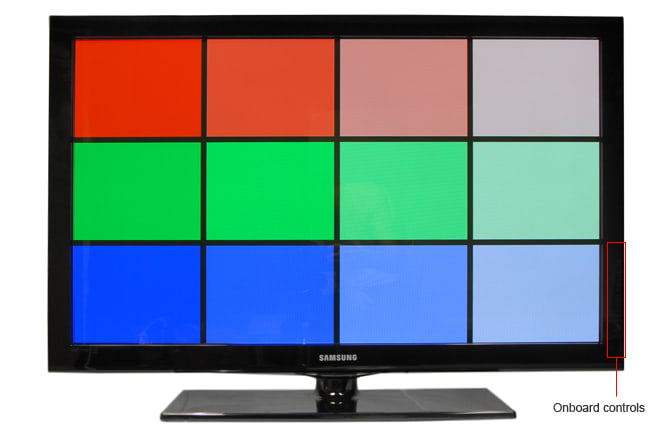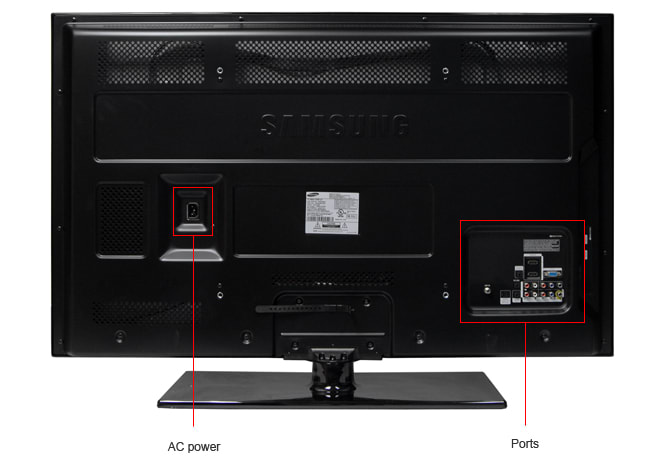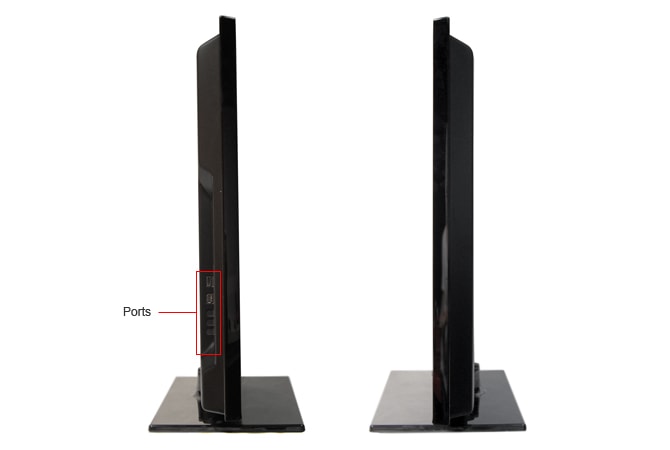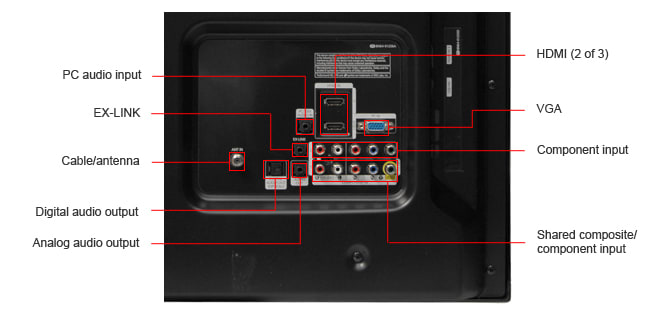Introduction
Tour & Design
The front of the Samsung PN42C450 has a thickish black bezel. Along the right side of the bezel are a series of touch-sensitive buttons for basic controls like power, volume, and channel up/down.

The back of the TV is a metal grill. Along the bottom corner are most of the ports. For information about the ports on the back of the Samsung PN42C450 see our Connectivity section.

The Samsung PN42C450 is not terribly thick for a plasma - at least it's thinner than most comparable Panasonics. There's a couple ports on the side, as well as a few decoys (beware!). For information about the ports on the sides of the Samsung PN42C450 see our Connectivity section.

The base is large and heavy, and the neck does not allow the TV panel to swivel. The parts that Samsung packed in the box feel extremely cheap. It was quite difficult to put in all the screws, like the parts didn't quite fit.
The Samsung PN42C450 has a series of touch-sensitive control "buttons" on the front of the frame to control power, volume, channel up/down, source, and menu. Because this whole area is essentially a fingerprint magnet, we recommend just using the remote.
The remote control that ships with the Samsung PN42C450 is simple and effective, similar to the remotes that ship with nearly all the Samsung TVs this year. For more details, jump to the Remote Control section.
Immediately upon trying to assemble the PN42C450, you can tell that Samsung is an LCD-first company, and that plasmas are an also-ran that the sell just to stay in the market. The parts feel distinctly cheaper and we had real trouble trying to get the screws into the holes. (Keep in mind we assemble and review TVs for a living, so we have a lot of reference to fall back on.) Of course, it makes sense that the plasmas would be made in a different factory than the LCDs, but we expect the same level of quality control. Once assembled, it felt sturdy enough.
The Samsung PN42C450 ships with the stand, remote control, batteries, instruction manual, and a cloth wipe.
The Samsung PN42C450 is an entirely average looking TV: black and boxy. The high-gloss finish attracts fingerprints like nothing you've seen before, so you'll probably be making use of that included cloth wipe in a hurry.
Blacks & Whites
The Samsung PN42C450 did not wow us with its black level, especially when you consider that black level is the supposed strength of a plasma. Admittedly, the TV is surely capable of getting deeper blacks than this if we played around with some of the settings, but this was the performance under the optimal calibration. Note in the chart below that the Sony and Samsung LCD displays are both capable of deeper blacks. (More on how we test Black Level.)
The Samsung PN42C450, like most plasmas, can't get nearly as bright as LCDs due to the risk of excessive heat. However, the picture was a lot brighter than some of the more expensive Panasonic plasmas we've reviewed. All in all, it's a decent performance. (More on how we test Peak Brightness.)
We measured the Samsung PN42C450's contrast ratio at approximately 1442:1, which is certainly not spectacular. If contrast is so important to you, there are special processing settings that increase the contrast. However, it comes at the cost of other areas of performance. For instance, the Dynamic Contrast setting constantly raises and lowers the cell lighting, which can be quite distracting.( More on how we test Contrast.)
The Samsung PN42C450, as a plasma display, has some troubles with maintaining a consistent black level. When the screen is mostly black, the levels are deeper than when it's a small patch of black surrounded by bright white. You probably won't find this too distracting. (More on how we test Tunnel Contrast.)
The Samsung PN42C450 has a little trouble with maintaining a consistent peak brightness. Most plasmas have this issue, in fact. For small patches of white, it can display a *very *bright white. However, that produces a lot of heat. If that white patch gets bigger, the TV has to lower the brightness in order to keep the TV chassis from melting. It's for your safety! Respect it. (More on how we test White Falloff.)
The Samsung PN42C450 has no problems with screen uniformity. (More on how we test Uniformity.)
The greyscale gamma measures how well a TV displays the transition from black to white. The chart below tells us a few different things. First, there's the shape. Ideally, we're looking for a smooth curve. The bumps in the lower left indicate some minor issues in the shadow details. It slope also becomes more horizontal, indicating that it won't be able to display every shade you might want to see in the shadows. The same thing happens on the upper right end of the slope, which represents the highlights. There's even more loss of detail here. However, the overall slope of the curve is very good. An ideal curve is somewhere between 2.1 and 2.2. The Samsung PN42C450's performance was a slope of 2.19. ( More on how we test Greyscale Gamma.)
Color Accuracy
The Samsung PN42C450 showed some issues with maintaining a consistent color temperature. As you can see from the chart below, it warms in little peaks for much of the signal spectrum, then cools considerably as it gets into the dark shadows. However, we wouldn't expect it to have much of an impact in everyday viewing. (More on how we test Color Temperature.)
The Samsung PN42C450 did not have the best RGB color curve performance we've seen. The three channels did not move in great unison. Each channel showed significant instances of "jaggies" in the line, which would manifest as color banding were you to see it on the screen. We were able to see several instances of the color banding with our own eyes. The blue channel, in particular, also showed problems in the midtones, being unable to differentiate a wide swath of signal. (More on how we test RGB Curves.)
The strips below are digital recreations of the color performance data points from the chart above. You can see how it compares to the competition, as well as an ideal response curve.
The Samsung PN42C450 didn't do a great job matching up to the rec 709 color standard. The green point was off considerably. The blue and red points were also off the mark, but less so. Most TVs do not match up all that well with the rec. 709 standards, so we don't consider it a huge failing. (More on how we test Color Gamut.)
The chart below has all the details about the Samsung PN42C450's performance.
Motion
The Samsung PN42C450 did a decent job in our motion tests. Objects moved with relatively good smoothness, as is the case with most plasma TVs we've reviewed. There was only a little flickering along high contrast borders. (More on how we test Motion.)
The motion artifacting that we saw on the Samsung PN42C450 was mostly an upswing in the amount of color banding. Areas of fine, complex shading were generally rendered as flat monotones or blocky chunks of color. Certain colors, like blue, were more noticeably prone to error.
The Samsung PN42C450 has a 720p resolution rather than the 1080p that we're seeing on the majority of 2010 TVs. Perhaps due to the some the resolution scaling problems (described below), we noted real problems with 24fps content display. High frequency patterns flickered with extreme annoyance, and there's no setting on the TV to improve 24fps performance. (More on how we test 3:2 Pulldown and 24fps.)
The Samsung PN42C450 is simply terrible at displaying high frequency patterns: think of stripes, checkerboard patterns, the anchorman's terrible houndstooth sports jacket, etc. – anything with tiny, repeating details in horizontal or vertical arrangement. The Samsung PN42C450 chokes on it, create some vicious Moire patterns and other anomalies. This section of the review normally looks for instances of these problems is the non-native resolutions. However, the Samsung PN42C450 was so bad in its native 720p that we wanted to give you a framework of comparison. (More on how we test Resolution Scaling.)
480p
The 480p content offered the better performance. It did, however, lose 2% of the top and bottom and 3% of the sides due to overscan.
1080i
The 1080i content we tested showed terrible, terrible problems with high frequency patterns.
1080p
The 1080p content also displayed very bad problems with high frequency patterns.
Viewing Effects
The Samsung PN42C450 is a native 720p display, which is almost unusual for a 2010 TV. Nearly every TV we've reviewed this year has been a 1080p. The Samsung PN42C450 is clearly flummoxed with higher resolutions, as evinced in our Resolution Scaling tests. However, it can display technically display all types of NTSC content (just don't expect amazing performance).
The Samsung PN42C450 is a plasma display, and despite any other weaknesses, the viewing angle is quite good. According to our tests, it measured approximately 153 degrees (77 degrees from center in either direction). That far exceeds what an LCD display can do, making plasmas an arguably better choice for servicing wide rooms. (More on how we test Viewing Angle.)
The Samsung PN42C450, like most plasma displays, casts a wide, soft glow when hit with ambient light. The problem with this type of glow is that it takes a serious toll on the already low contrast ratio. Shadows details are completely washed out. If you buy this TV, you'll need to take care where you position it and other lights in the room. (More on how we test Reflectance.)
The Samsung PN42C450 has a handful of video processing features. We turned most of them off in order to get the best video quality. You should feel free to experiment, though, and decide for yourself.
Calibration
[

](http://www.displaymate.com/)To get the best performance, we put the Samsung PN42C450 in Movie mode. This moved the color temperature to as close to 6500K as we could get. After that, we raised the Cell Light from a setting of 7 to a setting of 10. Normally, plasma TVs don't have a function like this, and our raising it probably hurt the black level score a little. But overall, we feel it's more important to calibrate for color than contrast ratio.
The Samsung PN42C450 has three video preset modes.
Remote Control

Ergonomics & Durability*(6.0)*
The remote control on the Samsung PN42C450 is a standard design for Samsungs of 2009 and 2010, with a few minor cosmetic changes. Overall, it has a good feel. The buttons are large and rubbery, and easy to differentiate by feel. The remote also seems sturdy enough that it can take a few falls and hold up alright.
The buttons are comfortable and uniquely shaped enough that you'll be able to tell them apart without looking down. It's just the right length, so you can reach most of the buttons without adjusting your grip.
Programming & Flexibility*(1.0)*
The remote control can be used to control other Samsung devices that work with the Samsung's Anynet+. However, it's not a universal remote.
Connectivity
The Samsung PN42C450 has enough ports to get you set up for a home theater, but it doesn't have the bells and whistles of some more expensive TVs. There are 3 HDMIs, though most HDTVs have 4. We appreciate the analog audio output (missing on Panasonic plasmas), but it lacks an ethernet port for streaming content or even DLNA support.

The ports are spread out along the back. On the side, you'll find an HDMI, USB, and three things that look like ports, but are not. These are just holes punched in the chassis. They probably get used in more expensive models, but not the C450 series.

The Samsung PN42C450 has two output ports, a digital audio output and an analog audio output. Between the two, you'll be able to connect to any home audio system, new or old.
The Samsung PN42C450 has no LAN port or WiFi option.
The Samsung PN42C450 has a USB port that can read thumb drives to play photos and music. More details in the Multimedia section.
The Samsung PN42C450's ports can be a little difficult to reach, thanks to a non-swivel base. All ports are clearly labeled, as well.
Audio & Menus
The Samsung PN42C450 has a decent set of speakers, but certainly nothing to match a standalone audio system. The large chassis seems to help with the overall sound quality, making it less tinny than we've heard on some ultra-thin TVs. The bass response is still lacking, like all TVs, but it's a little better.
The menu offers four preset modes. We preferred Standard mode to Movie mode. The latter pushed the inadequate bass sounds to the forefront, resulted in a lot of garbled noise. The menu also features a full equalizer, and the requisite Surround Sound emulator, which did little to improve the quality.
The Samsung PN42C450's menu is similar to what's on nearly every Samsung TV. The menu's main groupings are arranged vertically along the left side. Because that main bar rarely disappears, it's easy to keep track of where you are. If you get lost, simply hit the "Exit" button on the remote control.
Overall, it's a good design, and one that we've praised before.
The instruction manual that ships with the Samsung PN42C450 has a table of contents and an alphabetical index in the back. With these, you should be able to answer any questions pretty quickly. You can find the Samsung PN42C450's manual online here.
Multimedia & Internet
The Samsung PN42C450 does not have any internet features. There is no LAN port or WiFi accessibility, and hence no streaming content or DLNA support.
The USB port on the side can read thumb drives and display photos stored therein. When you plug the thumb drive in, you'll have to hit the "Media.P" button on the remote control to get things started. You'll be presented with a screen asking which device you'd like to open. It's moot point, we think, because there's only one possibility. Then you choose whether you want to view photos or music.Photos can be viewed one at a time or in a slideshow.
The USB port also allows you to play music. The interface is nearly identical to the how you play photos (described above). Again, you can set up a string of songs to play in a row and... voila! A jukebox on your TV. What will they come up with next?
The Samsung PN42C450 does not support any other type of media.
Power Consumption
The Samsung PN42C450 is a plasma TV, which typically draw a lot more power than an equivalently sized LCD display. The power draw also ranges wildly from one second to the next, depending on the screen content. If you watch nothing by dimly lit horror movies, your electric bill will be more expensive than if you're watching brightly lit sitcoms. (More on how we test Power Consumption.)
We found the Samsung PN42C450 to draw an average of 172.6 watts, which costs an average of $33.72 per year. You can see from the chart below how that compares to similar TVs.
Samsung does offer several ECO settings to reduce power draw, though some have an effect of video performance.
Vs Panasonic TC-P42S2
Value Comparison Summary
The Panasonic TC-P42S2 is a low to mid-priced plasma from the leading manufacturer of plasma TVs. It's a little more expensive than the Samsung PN42C450, but we found the performance to exceed in most respects. While the Samsung has a thinner profile, the quality of the parts was noticeably cheaper than any of the Samsung LCDs we've reviewed. Overall, we'd have to choose the Panasonic.
Blacks & Whites
The Panasonic TC-P42S2 managed a significantly darker black level than the Samsung PN42C450, which created a better contrast ratio for the Panasonic, as well. You could certainly change some settings on the Samsung to make the blacks deeper, but it would darken the peak brightness, as well, or otherwise negatively affect picture quality.
Color Accuracy
The Panasonic definitely outperformed the Samsung in our color tests. The color temperature remained steadier and the RGB color curves were much smoother.
Motion
The motion performance was more or less a draw between the Samsung PN42C450 and the Panasonic TC-P42S2. Both showed some issues with artifacting, specifically with colors getting "smeared" or broken up into chunky blocks.
Viewing Effects
The Panasonic took a slight lead in viewing angle, but only by a few degrees. As plasma TVs, both far exceed what even the best LCD is capable of.
Connectivity
The Panasonic has more AV inputs for older devices, as well as an SD card slow. However, it lacks a USB port and analog audio output. It's a matter of priorities. Decide what you need in a TV for connectivity and make that a part of your buying decision.
Vs Sony KDL-40NX700
Value Comparison Summary
The Sony KDL-40NX700 is a good example of how a little more money spent on a slightly smaller LCD TV can yield far more benefits. The NX700's performance far exceeds the Samsung PN42C450 in the key areas like contrast and color. It also includes built-in WiFi and a LAN port for streaming content and DLNA home theater support. The ultra-thin frame costs is a little screen uniformity and the viewing angle certainly won't match a plasma's but that seems a small price to pay.
Blacks & Whites
The Sony NX700 nearly matched the Samsung PN42C450's black level, and thanks to a much brighter peak white, the contrast ratio was far superior.
Color Accuracy
The color performance of the Sony NX700 was much better than the Samsung PN42C450. It did a better job of maintaining a consistent color temperature and didn't show the same color banding issues in our RGB curve tests.
Motion
The Sony NX700's motion artifacts were different from the Samsung's. We noticed more flickering and false color trails. On the Samsung the issues related to color banding and other specifically color-related problems.
Viewing Effects
The Samsung PN42C450, as a plasma, exceeded the weak viewing angle of the Sony by a large margin. In fact, the Samsung was over 3.5x wider.
Connectivity
The Sony offers much better connectivity options if you're home theater equipment is relatively new. It lacks the Samsung's extra component input, but it has an extra HDMI, a LAN port, and built-in WiFi.
Vs Samsung LN40C630
Value Comparison Summary
Samsung makes better LCDs than it does plasmas. That's not a conclusion we came to from this review, specifically, but it does help to confirm our opinion. Everything about the LN40C630 feels better – better parts, better looking menu appearance, as well as better performance and better features. Obviously, there's a price premium between these two exact models, but these are generalizations that can be applied to their entire LCD and plasma TV lines.
The fact that the Samsung PN42C450 only has a 720p resolution is a big strike against it. The inclusion of a LAN port and streaming content on the LN40C630 should help clinch the deal.
Blacks & Whites
Surprisingly, the LCD Samsung was able to get a much deeper black level than the plasma Samsung. Granted, you'd be able to deepen the blacks pretty easily through a few different options in the menu, but not without affecting peak brightness and other picture quality issues. And because the Samsung could produce that deep black and still get a very bright white under the same calibration settings, it has a much wider contrast ratio.
Color Accuracy
The Samsung PN42C450 had some real problems in our color testing, showing problems with color temperature and producing smooth curves in the red, green, and blue channels. The Samsung LN40C630 was certainly perfect, but managed better performance in both tests.
Motion
The Samsung LN40C630 produced much better results in our motion tests, though you'll want to employ some of the TV's special processing features when watching some types of content (read full review for details).
Viewing Effects
The Samsung PN42C450's plasma screen has one clear advantage over the Samsung LN40C630's LCD, and that's viewing angle. There's no contest: the PN42C630 was nearly 2.5x times wider.
Connectivity
The Samsung LN40C630 has a LAN port for streaming content and DLNA support, as well as an additional USB port.
Conclusion
Series Comparison
C450 Series
There are just two models in the PNxxC450 series. Both are 720p plasmas with a bare bones feature set. There's not much to recommend it except a low price for a big screen.
Meet the tester
David Kender oversees content at Reviewed as the Editor in Chief. He served as managing editor and editor in chief of Reviewed's ancestor, CamcorderInfo.com, helping to grow the company from a tiny staff to one of the most influential online review resources. In his time at Reviewed, David has helped to launch over 100 product categories and written too many articles to count.
Checking our work.
Our team is here to help you buy the best stuff and love what you own. Our writers, editors, and experts obsess over the products we cover to make sure you're confident and satisfied. Have a different opinion about something we recommend? Email us and we'll compare notes.
Shoot us an email